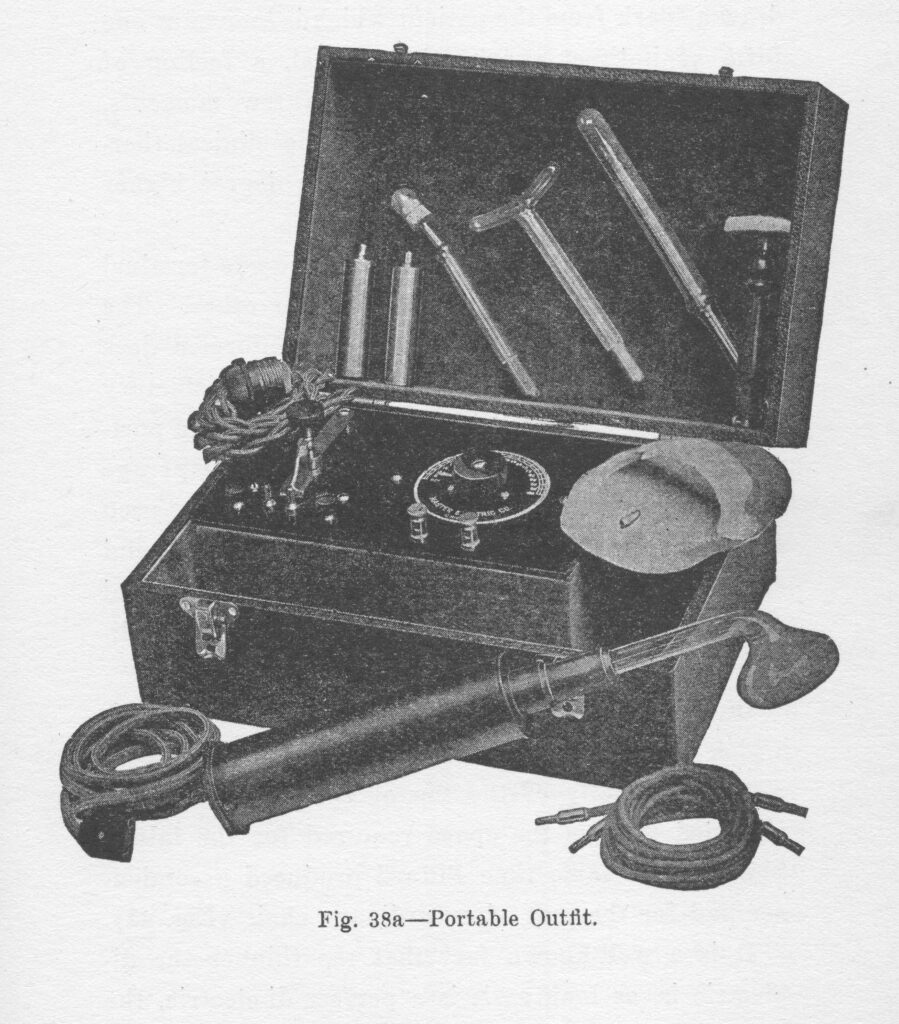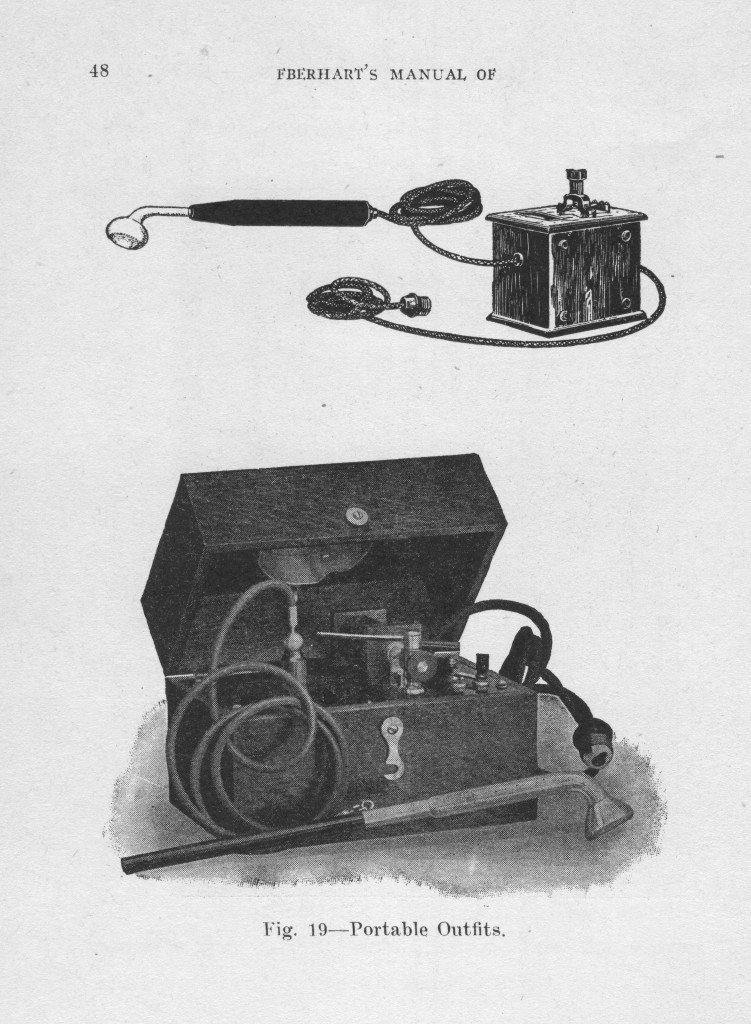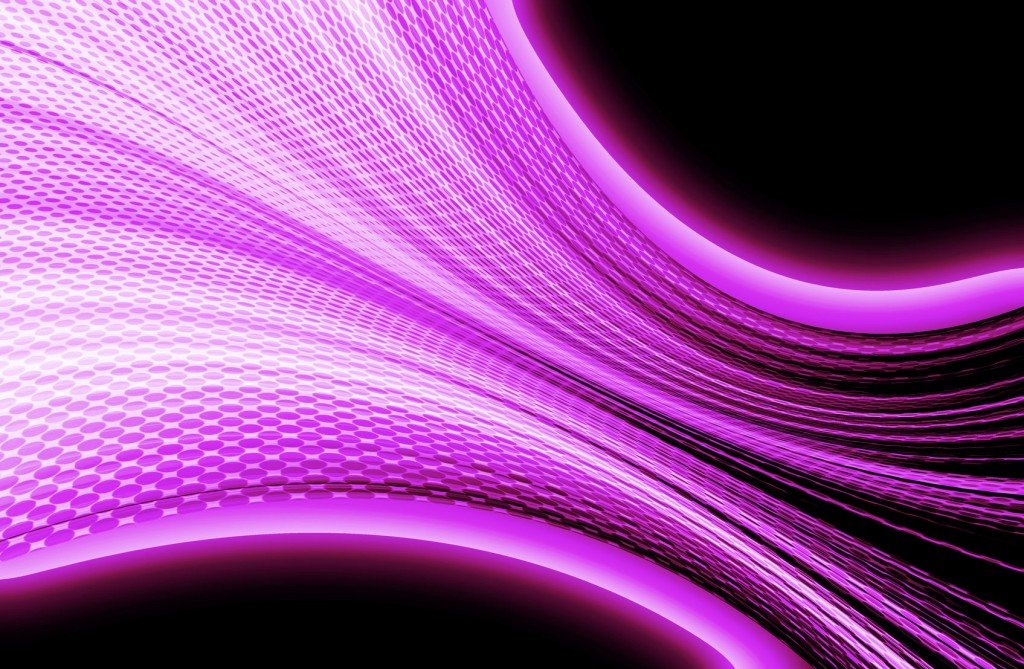Sussanna Czeranko, ND, BBE
Electricity is present, not only in all the objects of nature about us, but also in every human and animal being, therefore I maintain that it is this which constitutes the primal cause and preservative force of the life of functions.
- H. A. Schaefer, 1900, p.110
To overcome danger of shock Tesla also found it was necessary to give electricity in very small doses (homeopathically it might be expressed), and therefore, he reduced the amperage to practically a negative quantity in the Tesla coil with which Violet Ray is equipped.
- A. Martin, 1921, p.443
The Electro-Therapist using a Violet Ray machine accomplished the final cure, this by adjusting balance to the nervous system and restoring normal circulation.
- A. Martin, 1921, p.448
The Violet Ray in the early 20th century was heralded as an important discovery in the field of electrotherapy. The popularity of electric devices was as pervasive a century ago as today. The early naturopaths were themselves smitten with the mysteries of electricity. In an article published in 1900, Schaefer exclaims, “Nothing in modern science causes us so much amazement as electricity, the sovereign ruler of all.” (Schaefer, 1900, p.110) It was an exciting time with the wireless telegraph, the unrelenting spread of analog telephone systems, and the growth of X-ray use. The world of electricity offered much promise to the medical arts. This fascination is still with us as we are always on the lookout for new diagnostic and documentation tools in the form of devices in providing health care for our patients. One such electrotherapy that was prominent a century ago was the high-frequency device called Violet Ray.
 As Martin reports just after the end of WWI, “With the advent of electric lights and electric power motors, the medical profession set to work toward applying this electric force to the human system and with their then crude knowledge, they made machines known as static, galvanic and faradic.” (Martin, 1921, p.442) Although much was written about the potential of electricity, manifesting in various devices and protocols, the literature shows that little was understood about the larger and more sustained uses of electricity itself, in whatever medium of delivery or application. Nevertheless, assumptions were made and accumulated that electricity would answer many of the woes of disease. Unfortunately, that same literature reports that the early devices often did more harm than good. For example, many who were subjected to the early electric treatments “received violent currents … [and] it did not take long, however, to discover the error of these methods.” (Martin, 1921, p.442) When electricity is administered in low voltage to a human body, the effect is “violently contracting muscular tissue. If introduced in large volume it has the effect of shocking the nervous system to such an extent as to produce death.” (Martin, 1921, p.442) Indeed, the judicial system in this period soon employed this feature of electricity with inhumane ferocity.
As Martin reports just after the end of WWI, “With the advent of electric lights and electric power motors, the medical profession set to work toward applying this electric force to the human system and with their then crude knowledge, they made machines known as static, galvanic and faradic.” (Martin, 1921, p.442) Although much was written about the potential of electricity, manifesting in various devices and protocols, the literature shows that little was understood about the larger and more sustained uses of electricity itself, in whatever medium of delivery or application. Nevertheless, assumptions were made and accumulated that electricity would answer many of the woes of disease. Unfortunately, that same literature reports that the early devices often did more harm than good. For example, many who were subjected to the early electric treatments “received violent currents … [and] it did not take long, however, to discover the error of these methods.” (Martin, 1921, p.442) When electricity is administered in low voltage to a human body, the effect is “violently contracting muscular tissue. If introduced in large volume it has the effect of shocking the nervous system to such an extent as to produce death.” (Martin, 1921, p.442) Indeed, the judicial system in this period soon employed this feature of electricity with inhumane ferocity.
One man from this period was well known to the naturopathic community as one who recognized the dangers of electricity and contributed to its safe use. Martin weighs in about Nickola Tesla, stating, “In 1900 Nickola Tesla, [1856-1943] the greatest man in electrical research work, that this or any other country has ever known, directed his attention to investigating the reasons why electricity had proved a failure in the treatment of disease.” (Martin, 1921, p.442) Monell also weighs in: “In transforming the primary current into high-frequency discharges Tesla took from it some of its former properties. … It would no longer exert the same power through the same motor, it ceased to sear and burn in its track, and contact with it no longer struck the muscles with a paralyzing and deadly shock.” (Monell, 1910, p.24)
Recognizing that the human body had its own vibratory rate, Tesla concluded that “if electricity was to be introduced into the system in an acceptable form, it was necessary to harmonize by raising the vibrations or voltage to correspond or conform with the number of vibrations in the body.” (Martin, 1921, p.442) Monell describes how Tesla transformed raw electricity into a healing medium. He explains, “The alternating street current for light and power is usually a 110-volt, 60 cycle current, oscillating only 120 times per second. … When alternations rise above 10,000 per second and voltage mounts beyond the hundreds of thousands, these twin features put such currents into a class by themselves and they are called high frequency and high potential.” (Monell, 1910, p.27) Monell also described another of Tesla’s many feats. Tesla developed the ‘Tesla Coil’ which “atomize[d]… current into a spray discharge.” (Monell, 1910, p.27) The “Tesla Coil” increased the voltage or vibrations of electricity to 40 000 per minute from 110 volts and reduced amperage to practically nothing, making the machines safe for human use. (Martin, 1921, p.443) The muscular contractions and shocking so common with the earlier renditions of devices no longer occurred.
Martin was very interested in these developments and wrote on related aspects of the use of electricity in naturopathic treatment. For example, he writes, “the wavelengths of the different rays decrease from red to violet, the red having the longest, the violet the shortest wave lengths. Beyond the red and violet of the visible spectrum are rays which are invisible.” (Martin, 1921, p.446) We are all familiar with the current medical application of infrared or thermography for breast screening programs and with ultraviolet rays. These have had a long history in the treatment of various skins conditions. Lindquist explains that the wavelengths of X-rays are .01 to 5.0 AU [Angstrom Unit], compared to ultraviolet waves that measure 200 to 3900 AU with the larger infrared waves measuring 7700 AU to 0.04 cm long. (Lindquist, 1948, p.92) Martin reminds us, “The long waves red and infra-red rays diffuse heat and penetrate deeply; the shorter waves, the violet and ultra-violet, give little or no heat and are called cold rays. These rays are easily absorbed and do not penetrate as deeply as the heat waves.” (Martin, 1921, p.446)
The Violet Ray
The Violet Ray devices were manufactured by many companies but the device essentially looked and worked the same, with the exceptions of milliamperage currents used. The 2 most popular were:
- The D’Arsonval type [high frequency, not very high voltage, and high amperage],
- Tesla Transformer and Coil [very high frequency, alternate current, less amperage than the D’Arsonval] (Eberhart, 1910, p.30-37)
High-frequency currents that were attached to a vacuum tube “electrode” emitted a violet-colored light when in use. Monell explains: “Vacuum electrodes are made in various shapes to suit various purposes and also exhausted to different degrees of vacuum.” (Monell, 1910, p.204) The shapes of the electrodes were designed to deliver the current directly to the diseased part and were ideal “for aural, nasal or throat work, and for rectal, prostatic, urethral and vaginal treatments.” (Monell, 1910, p.205)
The Violet Ray was operated by setting it up with a glass tube electrode in the handle. The instructions were very straightforward: “Connect the patient to one terminal of the current, using either a bare metal handle, [included with the device] or metal plate, or wet-pad electrode, according to convenience in a minor case or effects wanted in an important case.” Like with all equipment, judgment and experience directed the choice of which was used. “With the vacuum electrode connected to the opposite terminal and the current at zero, grasp the head of the electrode lightly in the left palm and with the right hand run up the current until the tube is seen filled with a steady luminous glow and the bulb warms the hand in contact with it.” (Monell, 1910, p.206)
Treatment of the Patient
The vacuum glass tube came into direct contact with the patient’s skin. Eberhart cautions, “All metal, such as chains, corset-steels, wire hair pins, etc., with which the tubes comes in contact or within sparking distance of, will be charged with the current and give rise to sharp and disagreeable sensations. If they cannot be avoided they should be removed.” (Eberhart, 1920, p.83)
In any case, Martin advocated the Violet Ray with confidence, “There is no case on record of any injury having been sustained by anyone using Violet Ray properly or improperly, that, is to say with or without experience.” (Martin, 1921, p.449) He offered guidelines in the use of the Violet Ray. “The rule set down, however, being that ten minutes is the limit that any one should apply the current as no good can be accomplished by a longer treatment. … Two or three applications may be given in the course of 24 hours, if required; ordinarily one a day is sufficient.” (Martin, 1921, p.449) Eberhart stipulated that burns could be possible, warning his colleagues that “to avoid this, I make it a rule never to leave a vacuum tube in contact with a mucous membrane for more than seven minutes at a time.” (Eberhart, 1920, p.66)
Therapeutic Benefits
The Violet Ray instrument had numerous therapeutic benefits. The light and thermic properties of the Violet Ray offered “a stimulus to blood circulation and also to nerve action.” (Martin, 1921, p.443) Martin adds, “Light [and color] Therapy also enters as a part of Violet Ray treatment because [color] is produced in the vacuum tube when in operation. … The violet light is produced by the many ions of electricity discharged in the vacuum tube bombarding molecules within the tube, becoming most predominant and resulting in the phenomena of exhibiting a Violet light.” (Martin, 1921, p.443) However, the purple light, these early naturopaths reminded their colleagues and their patients, is accompanied by “Ultra-Violet Rays, invisible to the eye, yet particularly destructive to micro-organism.” (Martin, 1921, p.443) Ultraviolet is well known for its germicidal activity.
Monell and Eberhart outlined specific protocols for treating numerous diseases affecting every system in the body. The Violet Ray was effective in reducing “congestion and inflammations,” (Monell, 1910, p.258), “inducing relaxation in cardiac and nerves,” (Monell, 1910, p.88) and as a non-irritating antiseptic, “healing skin lesions and infections.” (Monell, 1910, p.102)
Naturopaths of the time understood that high-frequency current influenced the amount of urine excreted and increased the elimination of nitrogenous products and toxicity, as well as reduced uric acid in rheumatic patients and increased oxyhemoglobin. (Monell, 1910, p.93) High-frequency electrotherapies were also known to improve heart function, to normalize blood pressure, (Monell, 1910, p.98) and to restore normal function to the lymphatic system. (Monell, 1910, p.101)
Nevertheless, the literature documents that our early naturopathic colleagues knew that violet rays did generate heat that could harm. Because of their place on the color spectrum and their wavelength, violet rays were capable of irritating the skin. Eberhart states, “True, [the violet rays] do not cause a dermatitis, comparable to that produced by the X-ray, but they are still capable of causing annoying surface burns.” (Eberhart, 1920, p.64)
In Eberhart’s A Working Manual of High Frequency Currents, eight constitutional effects are listed:
- Increase general metabolism
- Increase glandular activity
- Increase temperature and bodily heat
- Increase oxidization and hemoglobin
- Increase secretions
- Increase elimination
- Lower blood pressure when hypertension exists
- Soothing to the nervous system
(Eberhart, 1920, p.64)
Some of the conditions that the Violet Ray was used for included: “neuritis, neuralgia, rheumatism, gout, sciatica, diabetes, asthma, dyspepsia, impotence, influenza, leucorrhea, paralysis, pneumonia, gonorrhea, hay fever, high blood pressure, anemia, and a wide range of other conditions.” (Puderbach, 1927, p.134) Reading through this list of ailments, one might conclude that the Violet Ray was a type of panacea. Monell, for example, utilizing the Violet Ray, lists many treatment plans in his book for chronic nephritis, tuberculosis, rheumatism, gout, headaches, neuralgias, and digestive complaints, to name a few. Eberhart lists an equally impressive list of conditions that Violet Ray high-frequency current successfully treated in their clinical experience.
Among the many references to the Violet Ray and its value to our naturopathic forebears, Martin brings to our attention, “the curative properties of Violet Ray treatment in cases of X-ray burns.” (Martin, 1921, p.446) It is important to note, as we consider today these details about the Violet Ray, that even a century ago the side effects and harmful effects of radiation were a worry of naturopaths. The deep penetration of X-rays facilitated tissue destruction in cases such as cancer. Martin states, “Frequent exposure to [X-rays] is dangerous, yet the very opposite maintains when speaking of Violet Ray or High Frequency which brings blood to the part instead of driving it away.” (Martin, 1921, p.446-447) While the Violet Ray was an effective treatment for numerous diseases by its action of stimulating blood flow, its use was contraindicated when treating conditions with an “already too great an accumulation of blood or where bringing blood to the parts would encourage malignant growth of abnormal tissue.” (Martin, 1921, p.449)
My first experience with the Violet Ray was in the medical office of Dr Letitia Dick-Kronenberg. She had an original Violet Ray which she uses regularly with her patients, with outstanding results. These tools and protocols from our early naturopathic pioneers live on !
 Sussanna Czeranko, ND, BBE is a CCNM graduate and is a licensed ND in Ontario and Oregon. Practicing since 1994, she has developed an extensive armamentarium of nature-cure tools and techniques for her patients, with special interest in balneotherapy and breathing therapy. In addition to clinical practice, she is the curator of the Rare Books Collection at NCNM. Her current project is a 12-book series entitled In Their Own Words, the first volume of which, Origins of Naturopathic Medicine, is now available from NCNM Press. The series restores to the profession the best of the early Lust journal literature. Sussanna founded The Breathing Academy, providing a scientific model of breathing therapy called Buteyko for naturopathic practice. Her next large project is to complete the development of a medical spa in Manitou Beach, Saskatchewan.
Sussanna Czeranko, ND, BBE is a CCNM graduate and is a licensed ND in Ontario and Oregon. Practicing since 1994, she has developed an extensive armamentarium of nature-cure tools and techniques for her patients, with special interest in balneotherapy and breathing therapy. In addition to clinical practice, she is the curator of the Rare Books Collection at NCNM. Her current project is a 12-book series entitled In Their Own Words, the first volume of which, Origins of Naturopathic Medicine, is now available from NCNM Press. The series restores to the profession the best of the early Lust journal literature. Sussanna founded The Breathing Academy, providing a scientific model of breathing therapy called Buteyko for naturopathic practice. Her next large project is to complete the development of a medical spa in Manitou Beach, Saskatchewan.
References
Eberhart, N.M. (1920). A Working Manual of High Frequency Currents. Chicago, IL: New Medicine Publishing Co., pp. 319.
Lindquist, R. J. (1948). Approach to Electrotherapy. Los Angeles, CA: R. J. Lindquist Publishing., pp. 136.
Martin, E.A. (1921). Violet rays or properly called high frequency. Herald of Health and Naturopath, XXVI(9), 442-449.
Monell, S.H. (1910). High Frequency Electric Currents. Racine, WI: Western Coil & Electrical Co., pp. 408.
Puderbach, P. (1927). Massage with violet rays. Herald of Health and Naturopath. XXXII(3), 134-138.
Schaefer, G.H.A. (1900). Natural therapeutics and electricity. The Kneipp Water Cure Monthly, I(7), 110-111.





